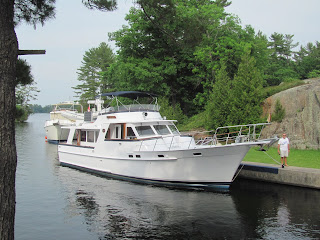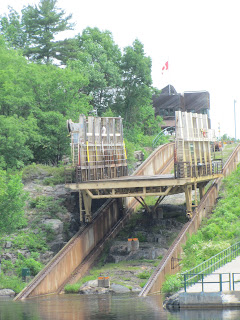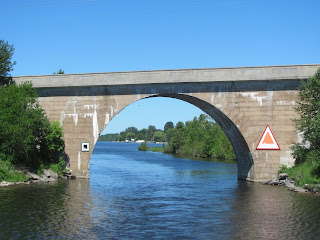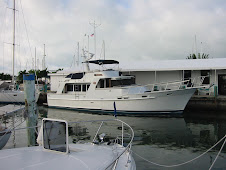Saturday, June 30, 2012
June 15-16, 2012 - Wrapping up the Trent-Severn Waterway
In the morning, we were good to go into the Swift Rapids Lock. The locktenders here, as at Lovesick, arrive via boat for their shift. This is our largest drop by a conventional lock on the Trent-Severn, at 47 feet and 1½ million gallons of water. After the drop, the lockmaster looks pretty small up there!
The family of campers had packed up, ridden down with us, and exited the lock as we waited our turn.
We were about to do something truly amazing; to pilot our boat over a road on a land rail! The Big Chute lift appears over the rise as we approach, while traffic on the road has been halted. Able to carry 110 tons and vessels up to 100’ in length, the marine rail has a complex system of straps that can carry multiple boats per trip.
Because of our size, we would get a solo ride. The Parks Canada staff directs us via loudspeaker.
Jerry steers Monarch right in the middle.
Parks staff gets the slings just right to support the boat fore and aft.
The rail car, Monarch included, rises up and out of the water. This is our only “lock” where there is no water to float the boat!
We can look down on the cars and trucks.
And then down we go, much steeper than our ascent.
Monarch’s stern sticks out significantly over the end of the rail car, but she rides just fine.
The Parks Canada staff really knows what they are doing, and bid us farewell.
As we settle in the water on the other side of the rise, we note the steepness of the grade on the downhill side. The rail car is kept level by the simple yet ingenious use of two different rail tracks for the fore and aft wheels.
Back underway, the shore is beautiful but very close!
We see more interesting boathouses.
This is our last lock, at Port Severn, the end or our Trent-Severn passage. Dating from 1850, the small town is the oldest community on the Severn River and was once dominated by the lumber industry. Today, it is the gateway to tourism in the Muskoka region, and features a few restaurants and two general stores.
Here and at many other locks, the spillways are adjusted by an antique-looking contraption that lowers 12” x 12” x 16’ timbers into slots to control the water flow to the lower side.
To celebrate our completion of the Trent-Severn Waterway, we had a nice dinner out that night. The next morning, Jerry spiffs up Monarch for the last lock.
We share the lock with a local boat, whose owner advises us about…..
…you guessed it, the upcoming tight channels and shallow water! Big surprise. This channel marks the way into the Georgian Bay.
Near this (outhouse? bus stop?) cute building, Monarch found a rock with her prop in Potato Island Channel, part of the small boat channel reported to have 5-6 feet of depth – which should be plenty for us – but not true. Just a little ding.
Once we found deeper water, we see lots of boats.
We also see many more cottages than we are used to around Stag Island. Some are modest…
…..and some aren’t. They all seem to have electricity, though they are on islands that appear to be far from civilization. They also have jet skis, fishing boats, ski boats, trawlers, motorboats, etc, and lots of them!
A nice spot to anchor for the night is just off Bone Island. We found a small cove with privacy. A lake bath was in order, with the air temperature at 88 degrees and the water at 75!
Refreshed, the captain relaxes. Tomorrow we begin to work our way toward Tobermory.
Thursday, June 28, 2012
June 12, 2012, Fenelon Falls to Swift Rapids, Ontario
This morning, we knew when the lock would be ready, as park personnel commute by boat to this lock, which is on an island.
Up the canal, we see a statue of a white-tail deer, and know we are at Buckhorn Lock. The lock personnel all along the canal were very customer-oriented. Yesterday, at Lakefield Lock 26 we had discovered a missing page from a set of navigation charts we had purchased 100 miles back. The lady locktender heard our plight, and arranged for a replacement – delivered today by her daughter, who is locktender here at Buckhorn Lock.
We appreciated the excellent navigational signs along the way.
There are hundreds of houseboats for rent on the canals, with the season just getting started.
We wished we had time to stop at Lock 32 in Bobcaygeon, which looked charming.
But we pressed on to Fenelon Falls, one of only two locks on the Trent-Severn offering lock wall tie up with shore power and water. We started the washing machine immediately!
We walked about town, locating the visitor information building, the public library with internet, restaurants, Sobey’s Supermarket, Tim Horton’s…..
…..and this convenience store with a green thumb, for today’s Globe and Mail newspaper. We learned that Fenelon Falls is one of only two Ontario towns to receive funding for a celebration of the Queen’s Diamond Jubilee – but it’s not until July 21, so we’ll have to miss the official flotilla planned to commemorate the Queen’s reign.
Next day, we have interesting cruising, with some very narrow channels…
…and rocks close to Monarch on each side.
Then Lock 36, the Kirkfield Lift Lock. Like the Peterborough Lift Lock in design but slightly smaller, this is a bigger thrill for us, as we are entering the lock at the top. It looks like we are driving Monarch right into space.
In our “tub” suspended nearly five stories in the air, we get a great view. Hope those cotter pins hold!
We both enjoy the ride. Take note: at the top of this lock, Monarch is at the highest point above sea level (841 feet) a boat can be driven under its own power in the world!
The lock structure has open girders, which makes us feel like we were really hanging out there!
This part of the canal includes shallow, weed-choked lakes and rivers, as well as man-made cuts. The Hole in the Wall Bridge, which spans the canal, is the first in Ontario to be built of reinforced concrete back in 1905.
After a night at Lock 37 – Bolsover’s upper wall, we moved along. For cottage owners in the area, boat houses are as important – if not more – than the cottage itself.
Here we had to wait about a half-hour for a bridge opening. There was no train in sight, and finally the bridge tender fired up a wheezy old engine, sputtering and coughing, and the bridge slowly and with great creaks and groans, swung barely out of the way.
This next pass reminded us of Little Detroit on the North Channel, very narrow, very close.
We docked for the night before the Swift Rapids Lock. This area is remote, served only by an eleven-mile long, rough two-track trail. Our company tonight included two groups of campers. A couple of fellows with backpacks and tents had hiked in and pitched a pup tent.
We docked for the night before the Swift Rapids Lock. This area is remote, served only by an eleven-mile long, rough two-track trail. Our company tonight included two groups of campers. A couple of fellows with backpacks and tents had hiked in and pitched a pup tent.
For a location for Fenelon Falls, check out the following MapQuest site - http://mapq.st/QvqzHw
Friday, June 22, 2012
June 10-11, 2012 - Peterborough to Lovesick Lock, Ontario

Now we move into cottage country known as the Kawartha Lakes region, with the rivers and lakes lined with cute cottages.

One has an interesting tree house.

Some locks have dog mascots. Scott Mills’ Lock 19 had a lock monkey to make sure the lock is working correctly. Sailors will appreciate this, as they have sometimes have stuffed anchor monkeys who watch to make sure the anchor doesn’t drag while the owners are away.

Next, on to bustling Peterborough, the largest town on the waterway with a population of 81,000. We tie up overnight at lock 20.

We went for a walkabout in downtown Peterborough, and to get Chuck’s car, which had been repositioned by a marina employee from Trenton. Part of our tour took us to check out the famous Peterborough Lift Lock, through which Monarch will pass tomorrow. We wanted to see this engineering marvel for ourselves prior to using it.

The Peterborough Lift Lock, opened in 1904, has a lift of 65 feet, making it the highest hydraulic lift lock in the world. It is the first of two built in North America, both on the Trent-Severn Waterway. The lock conveys boats in two water filled steel tubs, or chambers, each 140 feet long.

It operates on a balance principle; a constant water pressure supports a 65-foot high, 7½-foot diameter ram in each of two chambers, through connecting pipes below ground. When a foot of extra water from the river is let into the upper chamber, a connecting valve is opened and the heavier chamber automatically descends, forcing up the lower chamber to start a new cycle. It doesn’t matter how many boats are in each chamber, or their weight, as boats displace their weight in water.

This type of lock allows boats to ascend and descend in the same cycle, unlike more conventional locks. We were suitably impressed, and excited for Monarch’s transit of this amazing lock.

After a fine dinner at Riley’s rooftop restaurant, we retired to Monarch, and watched Little Lake’s fountain turn colors as the evening progressed.

We like the Trent-Severn Waterway before peak season; not only is traffic light and plenty of wall space available for docking, the locks operate on “banker’s hours,” starting at 9:00 a.m. and concluding at 4:00 p.m., giving us welcome short travel days! So at a most civilized hour, we departed for our much-anticipated trip up the Peterborough Lift Lock.

Charles points the way.

Our new friends, Craig and Barb, on Alacrity from Colorado Springs, go on ahead into the tub.

Boats are secured with mooring lines, fendered and packed in for efficiency.

Next, the lockmaster lifts the gates.

The lockmaster secures the gates with surprisingly lightweight pins, and in a humanitarian gesture, uses a coal shovel to scoop up panfish that have gotten trapped in the gate and return them to the water.

Then, the lift lock begins operation. It’s a smooth, quick ride to the top, much easier than conventional locks from the boat operator’s perspective. The water level doesn’t change, so lines don’t need to be tended.

We see breathtaking views all around at the top.

And the crew enjoys the ride.

Once we are released from the lift lock, Monarch pulls just close enough to the wall to let Chuck jump off for his trip home via car. He will be missed – bon voyage, Charles!

As with many places on the canal, it can be a tight fit for Monarch.

We saw loon parents tending two chicks.

A quaint church and cemetery mark this small town.

In the area, there are cottages large….

…..and small.

Taking up all of one tiny island is an Anglican Church. It holds services only in the summer months, and provides docks where parishioners can tie their boats.

Now we are among topography that reminds us of our beloved North Channel, and places like the Sow and Pigs.
 Stopping for the night at Lovesick Lock on Lovesick Lake, we learn the story behind the name. Young Indian Richard Fawn was hopelessly smitten by the beautiful Irish lass Katharine O’Donahue. Her father would have none of it, and the heart broken Fawn vowed to anguish in solitude for the rest of his life. With the plaintive wail of the loon echoing in the morning mist, the forlorn native paddled his canoe to a nearby island. Here he pined away for days, until his buddies found him, pathetic and near exhaustion and convinced him there were other fish in the sea. (Or something like that!)
Stopping for the night at Lovesick Lock on Lovesick Lake, we learn the story behind the name. Young Indian Richard Fawn was hopelessly smitten by the beautiful Irish lass Katharine O’Donahue. Her father would have none of it, and the heart broken Fawn vowed to anguish in solitude for the rest of his life. With the plaintive wail of the loon echoing in the morning mist, the forlorn native paddled his canoe to a nearby island. Here he pined away for days, until his buddies found him, pathetic and near exhaustion and convinced him there were other fish in the sea. (Or something like that!)
Subscribe to:
Posts (Atom)














































